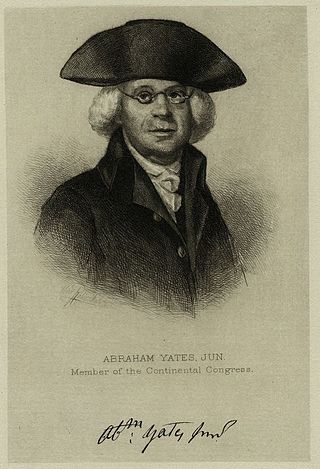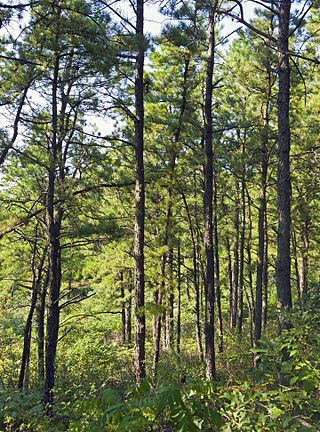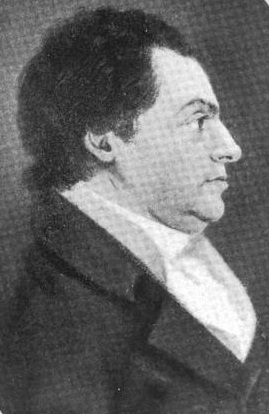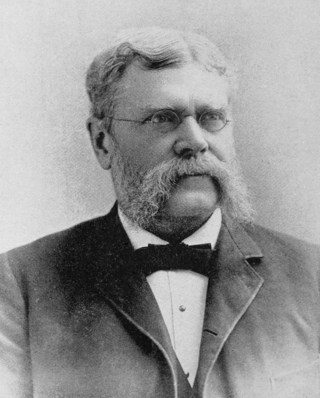Jonathan Pearson (February 23, 1813 - June 20, 1887) was an American botanist and historian. [1]
Jonathan Pearson (February 23, 1813 - June 20, 1887) was an American botanist and historian. [1]
Pearson was born in Chichester, New Hampshire, where his father worked as a miller. [2] From 1832 to 1835 he attended Union College in Schenectady, New York, as a student before taking a position as a tutor in 1836, eventually becoming a professor. [2] Along with professorial positions, Pearson was the college's librarian from 1839 to 1886, and treasurer. [1]
In April 1841 he married Mary Lord Hosford, and they had three children. [3]
He died in Schenectady on June 20, 1887. [4]
His diaries are held by the Union College library. [5]
Pearson appears to be best known as a local historian who was particularly focused upon the history of Schenectady. [6] He was also a plant collector and accomplished botanist, and was particularly interested in the local flora of his town. [7]
A small number of specimens collected by Pearson are held by the National Herbarium of Victoria Royal Botanic Gardens Victoria, and the National Museum of Natural History, France. [8] [9] His collecting labels are identifiable through their Latinisation; Pearson is identified as Iona. Pearson and his collections are from Schenectadiae, Nov. Ebor.


Albany County is a county in the state of New York, United States. Its northern border is formed by the Mohawk River, at its confluence with the Hudson River, which is to the east. As of the 2020 United States Census, the population was 314,848. The county seat and largest city is Albany, which is also the state capital of New York. As originally established by the English government in the colonial era, Albany County had an indefinite amount of land, but has had an area of 530 square miles (1,400 km2) since March 3, 1888. The county is named for the Duke of York and of Albany, who became James II of England.

Albany is the capital city of the U.S. state of New York and the seat of Albany County. It is located on the west bank of the Hudson River, about 10 miles (16 km) south of its confluence with the Mohawk River, and about 135 miles (220 km) north of New York City.

Schenectady is a city in Schenectady County, New York, United States, of which it is the county seat. As of the 2020 census, the city's population of 67,047 made it the state's ninth-largest city by population. The city is in eastern New York, near the confluence of the Mohawk and Hudson rivers. It is in the same metropolitan area as the state capital, Albany, which is about 15 miles (24 km) southeast.

Abraham Yates Jr. was an American lawyer, civil servant, and pamphleteer from Albany, New York.

The Albany Pine Bush, referred to locally as the Pine Bush, is one of the largest of the 20 inland pine barrens in the world. It is centrally located in New York's Capital District within Albany and Schenectady counties, between the cities of Albany and Schenectady. The Albany Pine Bush was formed thousands of years ago, following the drainage of Glacial Lake Albany.
Henry Glen was a merchant, military officer and politician who served as a Federalist in the United States House of Representatives during the years immediately following the adoption of the United States Constitution.
Verdoy, formerly known as Watervliet Center, is a hamlet of the town of Colonie in Albany County, New York, United States. Much of Verdoy is in the Airport Noise Overlay District due to its immediate proximity to Albany International Airport's main north/south runway, which was recently extended by 1,300 feet to the north, moving it even closer to Verdoy. The former Troy & Schenectady Branch of the New York Central Railroad runs along Verdoy's northern border with the Mohawk River; it is now part of the Mohawk Hudson Hike/Bike Trail.

Charles Horton Peck was an American mycologist of the 19th and early 20th centuries. He was the New York State Botanist from 1867 to 1915, a period in which he described over 2,700 species of North American fungi.

Culture in New York's Capital District, also known as the Albany metropolitan area, stretches back to the 17th century. The area has seen prominent historical events, interesting artistic creations, and unique contributions to the culture of the United States. The largest city in the area, Albany, consistently ranks high on lists of top cities/metro areas for culture, such as being 23rd in the book Cities Ranked & Rated. The Albany-Schenectady-Troy metro area ranked 12th among large metro areas, and Glens Falls ranked 12th among the small metro areas, in Sperling's Best Places, and Expansion Management gave the Albany-Schenectady-Troy area five Stars, its highest ranking, for quality of life features.
West Albany is a hamlet in the town of Colonie, Albany County, New York, United States. Parts of the neighboring city of Albany around Watervliet Avenue Extension and Industrial Park Road are also considered part of West Albany and includes the majority of the West Albany Rail Yard. The hamlet lies along Albany's northern border and was once home to many industries, including one of the largest cattle stockyards in the United States, a large railroad switching yard, and a Tobin First Prize packing plant. Those industries are gone now and the community is mostly a residential suburb of Albany in the shadow of abandoned industrial complexes. West Albany has historically been ethnically diverse with Polish, Italian, Irish, German, and English immigrants drawn by the 5,000+ jobs at the West Albany Rail Yard. Though the neighborhood is predominately Italian-American, it remains diverse with the Polish American Citizens Club, the West Albany Italian Benevolent Society, the Bet Shraga Hebrew Academy, and a Korean worship center in the former St. Francis de Sales Catholic Church.
Lisha Kill is a hamlet in the town of Colonie, Albany County, New York, United States. Lisha Kill lies on New York Route 5 in the western section of the town. The hamlet received its name from the creek of the same name, Lisha Kill, kill being Dutch for creek or stream. The stream is also referred to as Lisha's Kill and received its name from a local legend about a Native American woman who is buried along its banks.
New Salem is a hamlet in the town of New Scotland, Albany County, New York, United States. It is located in a valley at the foot of the Helderberg Escarpment along New York State Route 85. A local fair and car show is held every year in this small hamlet. It is also home to the town of New Scotland's community center and museum.

Philip Schuyler Van Rensselaer was the mayor of Albany, New York on two occasions. He has the third longest tenure of service by an Albany Mayor, after Erastus Corning 2nd and Gerald Jennings.
Johannes Pieterse van Brugh (1624–1697) was one of the early settlers of New Netherland and is the progenitor of the Van Brugh family in the United States. He was prominently connected with the Dutch West India Company as a fur and timber trader in both Rensselaerswyck and New Amsterdam.

George Rogers Howell was an American historian, genealogist, and science fiction writer.
Myndert Schuyler was a colonial trader and merchant with extensive real estate holdings who served as Mayor of Albany, New York, twice between 1719 and 1725.
David Davidse Schuyler was a colonial fur trader who was mayor of Albany, New York, from 1706 to 1707.
Dirck Wessel Ten Broeck was an American landowner, soldier, politician who served in the 1st and 2nd New York State Legislatures.
Jacob H. Ten Eyck was an Albany merchant and alderman who served as a member of the New York General Assembly.
Ryer Jacobse Schermerhorn was a merchant, politician and judge in provincial New York. He was the progenitor of the Schenectady branch of the Schermerhorn family.